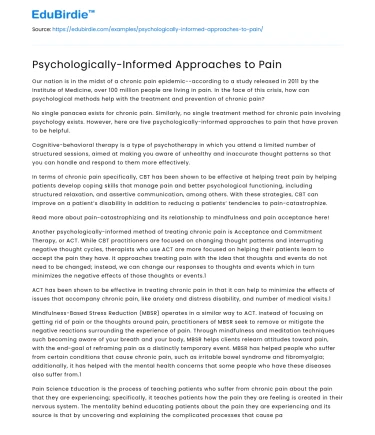Our nation is in the midst of a chronic pain epidemic--according to a study released in 2011 by the Institute of Medicine, over 100 million people are living in pain. In the face of this crisis, how can psychological methods help with the treatment and prevention of chronic pain?
No single panacea exists for chronic pain. Similarly, no single treatment method for chronic pain involving psychology exists. However, here are five psychologically-informed approaches to pain that have proven to be helpful.
Save your time!
We can take care of your essay
- Proper editing and formatting
- Free revision, title page, and bibliography
- Flexible prices and money-back guarantee
Cognitive-behavioral therapy is a type of psychotherapy in which you attend a limited number of structured sessions, aimed at making you aware of unhealthy and inaccurate thought patterns so that you can handle and respond to them more effectively.
In terms of chronic pain specifically, CBT has been shown to be effective at helping treat pain by helping patients develop coping skills that manage pain and better psychological functioning, including structured relaxation, and assertive communication, among others. With these strategies, CBT can improve on a patient’s disability in addition to reducing a patients’ tendencies to pain-catastrophize.
Read more about pain-catastrophizing and its relationship to mindfulness and pain acceptance here!
Another psychologically-informed method of treating chronic pain is Acceptance and Commitment Therapy, or ACT. While CBT practitioners are focused on changing thought patterns and interrupting negative thought cycles, therapists who use ACT are more focused on helping their patients learn to accept the pain they have. It approaches treating pain with the idea that thoughts and events do not need to be changed; instead, we can change our responses to thoughts and events which in turn minimizes the negative effects of those thoughts or events.1
ACT has been shown to be effective in treating chronic pain in that it can help to minimize the effects of issues that accompany chronic pain, like anxiety and distress disability, and number of medical visits.1
Mindfulness-Based Stress Reduction (MBSR) operates in a similar way to ACT. Instead of focusing on getting rid of pain or the thoughts around pain, practitioners of MBSR seek to remove or mitigate the negative reactions surrounding the experience of pain. Through mindfulness and meditation techniques such becoming aware of your breath and your body, MBSR helps clients relearn attitudes toward pain, with the end-goal of reframing pain as a distinctly temporary event. MBSR has helped people who suffer from certain conditions that cause chronic pain, such as irritable bowel syndrome and fibromyalgia; additionally, it has helped with the mental health concerns that some people who have these diseases also suffer from.1
Pain Science Education is the process of teaching patients who suffer from chronic pain about the pain that they are experiencing; specifically, it teaches patients how the pain they are feeling is created in their nervous system. The mentality behind educating patients about the pain they are experiencing and its source is that by uncovering and explaining the complicated processes that cause pain, practitioners can help alleviate anxiety and stress that patients have surrounding their chronic pain. In some cases, such as in groups that suffer from lower back pain, Pain Science Education has created some positive improvements in short-term pain suffering.
Psychologically Informed Physical Therapy (PIPT) is the incorporation of certain cognitive principles into the practice of physical therapy. By including cognitive-behavioral techniques like reframing thoughts, mindfulness, breathe work, relaxation training, education about the importance of sleep, positive coping skills, and planning for pleasant and enriching activities, PT’s are able to address physical and psychosocial factors of pain care. Additionally, the expectation is that physical therapists should be able to recognize pain that comes from psychosocial distress and to adjust their course of treatment accordingly.
Hopefully, through these psychologically-based methods and others that focus on treating pain in a more holistic way, we can combat this national pain epidemic we currently encounter.






 Stuck on your essay?
Stuck on your essay?

